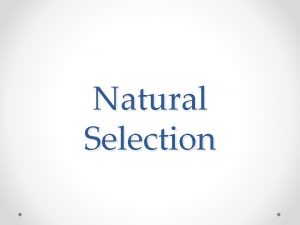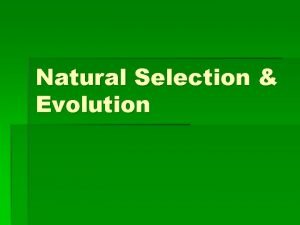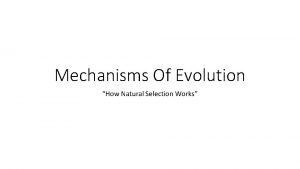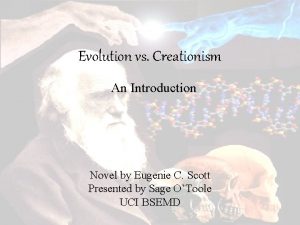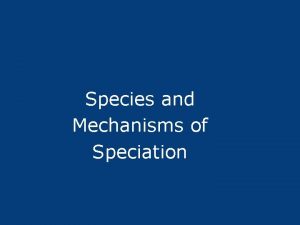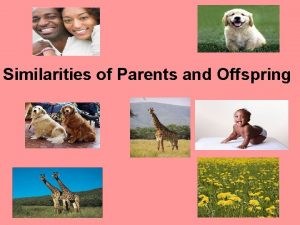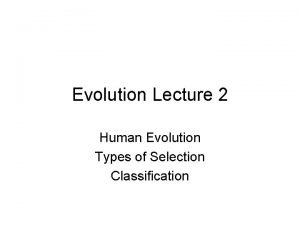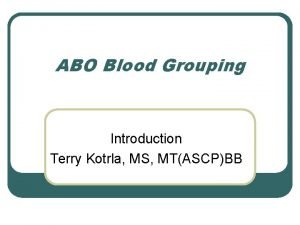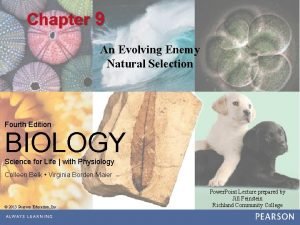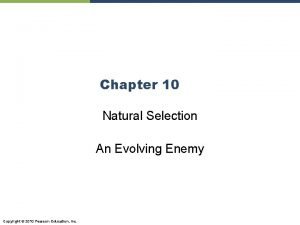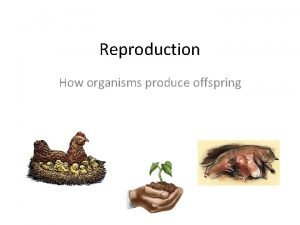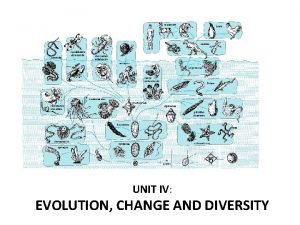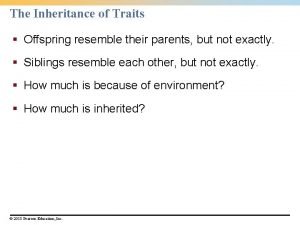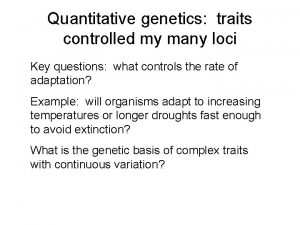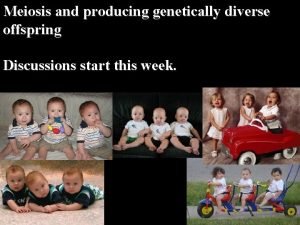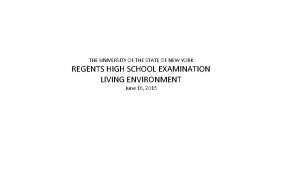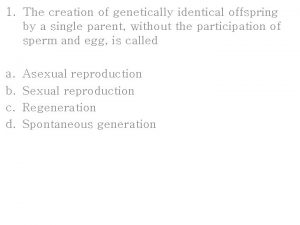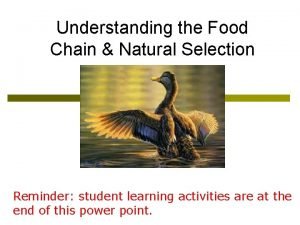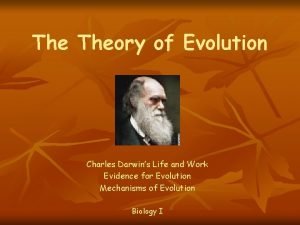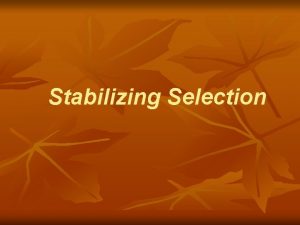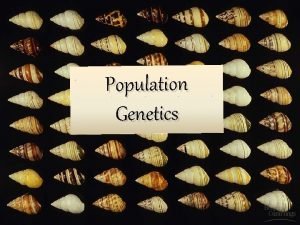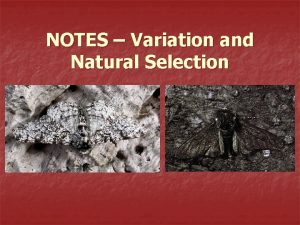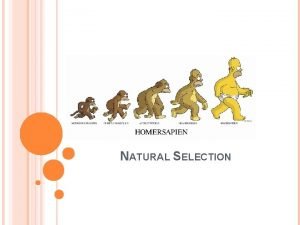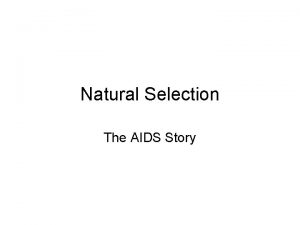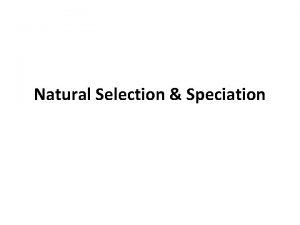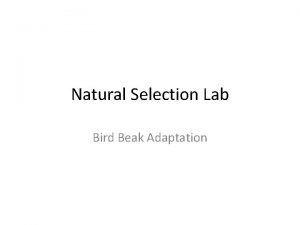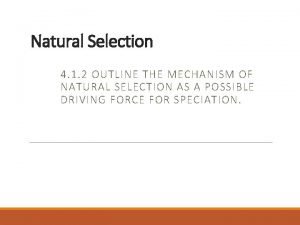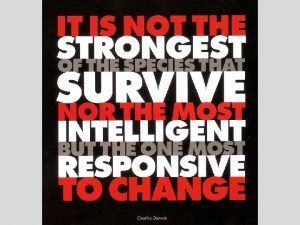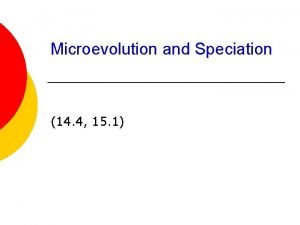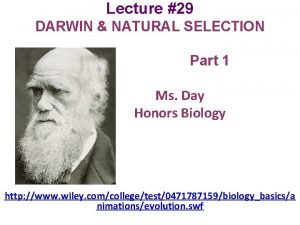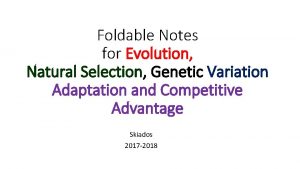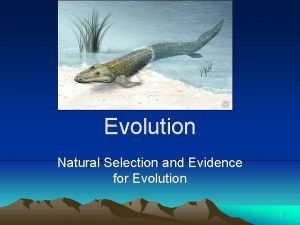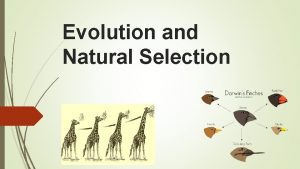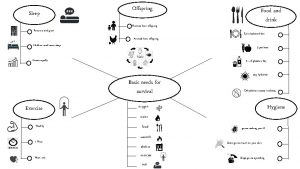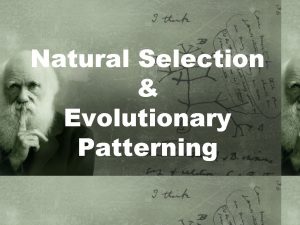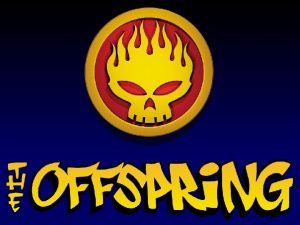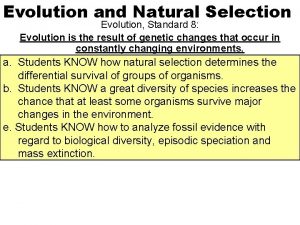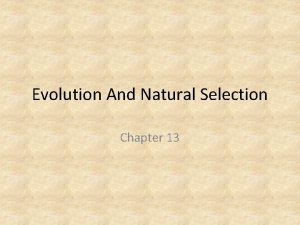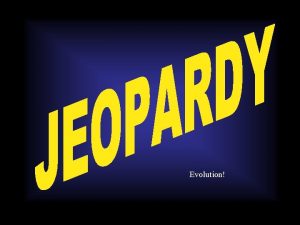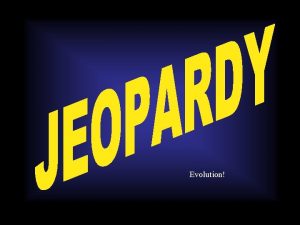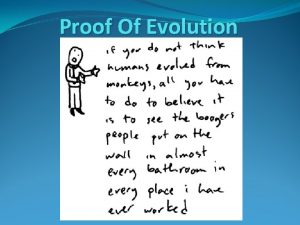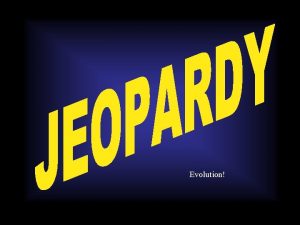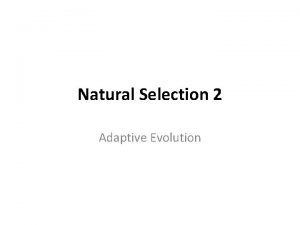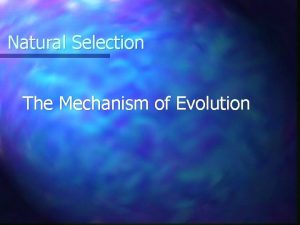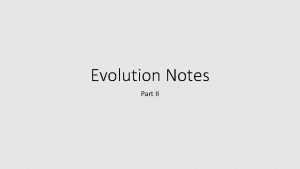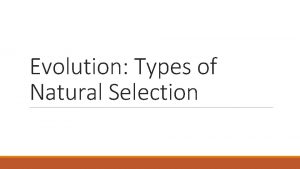Natural selection and evolution Natural Selection More offspring





























































- Slides: 61

Natural selection and evolution

Natural Selection More offspring than will survive Individuals vary in the population Individuals with certain variations will survive in their environment, pass on those variations to the next generation Overtime, offspring with certain variations make up MOST of the population

Theory of Evolution A. Idea supported by scientific evidence (but no concrete experiments) over a long period of time B. Change in a species due to mutation of the DNA code that occurs over a long time

Evolution of Air Breathing:

Charles Darwin Natural Selection: • “Survival of fit” • Fit reproduce • Competition for resources • Best adapted species survive

Darwin explains natural selection • Individuals with certain useful variations, such as speed, survive in their environment, passing those variations to the next generation.

Darwin explains natural selection • Over time, offspring with certain variations make up most of the population and may look entirely different from their ancestors.

Adaptations: Evidence for Evolution • Recall that an adaptation is any variation that aids an organism’s chances of survival in its environment. • Darwin’s theory of evolution explains how adaptations may develop in species. • According to Darwin’s theory, adaptations in species develop over many generations.

Structural adaptations arise over time • Some other structural adaptations are subtle. • Mimicry is a structural adaptation that enables one species to resemble another species.

Structural adaptations arise over time • In one form of mimicry, a harmless species has adaptations that result in a physical resemblance to a harmful species. • Predators that avoid the harmful looking species also avoid the similar-looking harmless species.

Structural adaptations arise over time • In another form of mimicry, two or more harmful species resemble each other. • For example, yellow jacket hornets, honeybees, and many other species of wasps all have harmful stings and similar coloration and behavior.

Structural adaptations arise over time • Predators may learn quickly to avoid any organism with their general appearance.

Structural adaptations arise over time • Another subtle adaptation is camouflage, an adaptation that enables species to blend with their surroundings. • Because well-camouflaged organisms are not easily found by predators, they survive to reproduce.

Physiological adaptations can develop rapidly • In general, most structural adaptations develop over millions of years. • However, there are some adaptations that evolve much more rapidly. • For example, do you know that some of the medicines developed during the twentieth century to fight bacterial diseases are no longer effective?

Physiological adaptations can develop rapidly Non-resistant bacterium Antibiotic Resistant bacterium The bacteria in a population vary in their ability to resist antibiotics. When the population is exposed to an antibiotic, only the resistant bacteria survive. The resistant bacteria live and produce more resistant bacteria.

Physiological adaptations can develop rapidly Non-resistant bacterium Antibiotic Resistant bacterium • Today, penicillin no longer affects as many species of bacteria because some species have evolved physiological adaptations to prevent being killed by penicillin.

Physiological adaptations can develop rapidly • Physiological adaptations are changes in an organism’s metabolic processes. • In addition to species of bacteria, scientists have observed these adaptations in species of insects and weeds that are pests.

Evolution Evidence: 1. Adaptations 2. Fossils 3. Comparative anatomy 4. Comparative embryology 5. Comparative Biochemistry 6. Plate Tectonics

1. Adaptations: features suited to a particular environment that allow organisms to survive Inuit people, who live in the extreme cold of the Arctic, have short, stout bodies that conserve heat.

Masai people, who live in the arid lands of eastern Africa, have tall, lean bodies that disperse heat well.

Plant Adaptations: Help!!! Venus Fly Trap • Captures Animals • Acquires Minerals • For Photosynthesis

Leaf Adaptations: Succulents • Thick • Store Water • Prevent Drying out

Leaf Adapatations: Pine Needles • Shed snow • Less water loss • Reduced surface area • Tolerate wind

Flower Adaptations: Fly pollination: • Hair along petals • Putrid smell Bee pollination: • Smooth petal • Sweet smell

2. Fossil Evidence • : Once living remains of organisms • Limited: 1. Type of material preserved (bone, shell, impressions, amber) 2. Incomplete record

Plant Fossil Evidence:

3. Comparative Anatomy: Structural similarities link related species

Comparative Anatomy Structures: Analogous: 1. Different ancestors 2. “analogy”=like 3. Different underlying structures 4. Same Function 5. Similar Environments Homologous: 1. Same ancestor 2. “homo”=same 3. Same underlying structures 4. Different Functions 5. Different

Analogous Structures • Different underlying structures (different ancestors) • Same function, similar environments Bird Wing Fly wing

Homologous Structures: Same underlying structures, different functions, different environments & common ancestor Bird Wing Porpoise Flipper

5. Comparative Biochemistry • Similar DNA sequences= • Similar Gene segments of the DNA • Code for similar traits • In closely related species

6. Plate Techtonics • Geological theory: • Continental masses were one land mass that explains • Closely related species have common ancestors on now separated continents


Gene pool? • Group of reproducing organisms • Specific frequency of allele types: 25% AA 50% Aa 25% aa

Changes in the Gene Pool: • Changes in the environment= • New mix of allele frequencies: 10% aa 60% Aa 30% AA Dominant had advantage

Variations: • Differences in traits • Come about by mutations in genes • Random • Occur in sex cells • Passed on to future generations

Bird Beak Adaptations:

Genetic Drift Changes in the gene pool due to: 1. 2. 3. 4. 5. Random mating Over a long time period No immigration of males No emigration of females Sufficient resources that match the adaptations

Same Species Must: • Show similar characteristic s • Successfully interbreed • Producing fertile Donkey + Horse= Mule (infertile) offspring

Speciation • Evolution • New Species • Over time • By Isolation • Natural Barriers

Reproductive Isolation due to… Geographical isolation Mechanical Incompatibility Behavioral isolation Seasonal isolation

Mechanical

original population geographical isolation ecological isolation genetic divergence reproductive isolation

Geographic Isolation • Separation of organisms by geographic features • Mountains • Lakes, oceans, rivers • Desserts (May result in new species over time)

Speciation • Evolution • New Species • Over time • By Isolation • Natural Barriers

Reproductive Isolation When two different species can not mate and have successful offspring –Geographic barriers –Anatomy or physiology –Social behaviors

Reproductive Isolation: Two organisms cannot mate • Separated by geographic boundaries • Anatomical differences • Physiological differences • Social behaviors

Seasonal

Sterility Male donkey & female horse makes a mule + =

Sterility Female donkey and male horse makes a “hinny”

Sterility Liger Zonkey

Gradualism • “gradual” • Small changes • Over a long time

Punctuated Equilibrium • “punctuation! ” • Large changes • Happen rapidly • Periods of no change

• Gradualism: # S P E C I E S Time • Punctuated Equilibrium

Adaptive Radiation: • “radiation”= branching from one source • “adaptive”= survival of fit Evolution of many branches of organisms from a single source

Patterns of Evolution • Adaptive radiation - when a single species has evolved, through NS, into diverse forms that live in different ways – Ex. ) Darwin’s Finches

Adaptive Radiation

Divergence Human arm • “diverge”= • • Bat wing branch off Cat limb Whale Homologous flipper structures Same origin Same underlying structure Difference Original Species: functions Mammal

Convergence Bird wing • “converge”=come together” • Analogous features Organisms that fly • From different origins • Similar environments= Butterfly wing • Similar functions Bat wing • Different structures

Patterns of Evolution • Convergent evolution - when unrelated organisms begin to resemble one another – It has occurred in both plants animals – Ex. ) Swimming animals &

Patterns of Evolution • Coevolution - when 2 species evolve in response to changes in each other over time – Ex. ) Orchid has long spur with nectar in its tip, a Hawk moth has equally long feeding tube that allows it to feed on the nectar
 Lirik lagu more more more we praise you
Lirik lagu more more more we praise you More more more i want more more more more we praise you
More more more i want more more more more we praise you What's natural selection
What's natural selection Types of natural selection in evolution
Types of natural selection in evolution Genetic drift vs gene flow vs natural selection
Genetic drift vs gene flow vs natural selection Natural selection vs evolution
Natural selection vs evolution Similarities
Similarities Natural selection vs artificial selection
Natural selection vs artificial selection Difference between continuous and discontinuous variation
Difference between continuous and discontinuous variation Disruptive selection example
Disruptive selection example Natural selection vs artificial selection
Natural selection vs artificial selection Human history becomes more and more a race
Human history becomes more and more a race Assortative
Assortative How are similarities passed from parent to offspring
How are similarities passed from parent to offspring Evolution types
Evolution types Two way selection and multiway selection in c
Two way selection and multiway selection in c Multiway selection
Multiway selection Mass selection and pure line selection
Mass selection and pure line selection The more you take the more you leave behind
The more you take the more you leave behind The more you study the more you learn
The more you study the more you learn Aspire not to have more but to be more
Aspire not to have more but to be more What is the relationship between inertia and mass
What is the relationship between inertia and mass Knowing more remembering more
Knowing more remembering more More love to thee o lord
More love to thee o lord More choices more chances
More choices more chances A and b blood type offspring
A and b blood type offspring A and b blood type offspring
A and b blood type offspring Natural selection and drug resistance
Natural selection and drug resistance Natural selection
Natural selection Balancing selection vs stabilizing selection
Balancing selection vs stabilizing selection K selection r selection
K selection r selection What is exponential growth in ecology
What is exponential growth in ecology Produce an offspring
Produce an offspring Reflection about sexual and asexual reproduction
Reflection about sexual and asexual reproduction Convergent evolution
Convergent evolution Why do offspring resemble their parents
Why do offspring resemble their parents Achillea millefolium
Achillea millefolium Diverse offspring
Diverse offspring Offspring
Offspring 16 punnett square
16 punnett square The molecule dna contains the four bases listed below.
The molecule dna contains the four bases listed below. Offspring countable or uncountable
Offspring countable or uncountable The creation of genetically identical offspring
The creation of genetically identical offspring Natural capital and natural income
Natural capital and natural income Sperm parts
Sperm parts 4 principles of natural selection
4 principles of natural selection Stabilizing natural selection definition
Stabilizing natural selection definition Genetic drift
Genetic drift Different types of natural selection
Different types of natural selection Natural selection
Natural selection Basketball player aids
Basketball player aids 3 types of natural selection
3 types of natural selection Bird beak adaptation lab
Bird beak adaptation lab Genetic drift
Genetic drift Natural selection
Natural selection Ted ed evolution
Ted ed evolution Macroevolution vs microevolution
Macroevolution vs microevolution Natural selection
Natural selection What was lamarck's theory of evolution
What was lamarck's theory of evolution Natural selection foldable
Natural selection foldable Example of vestigial structure
Example of vestigial structure Requirements for natural selection
Requirements for natural selection


